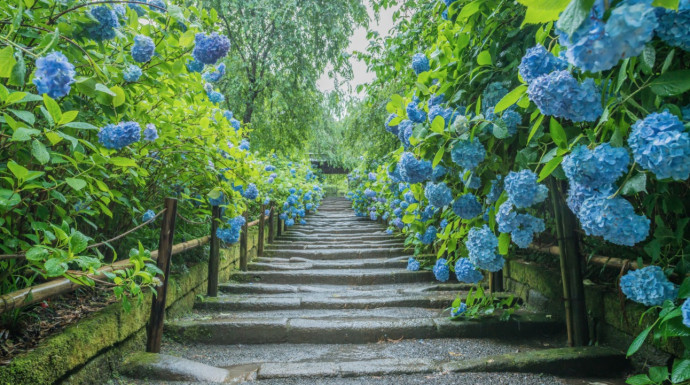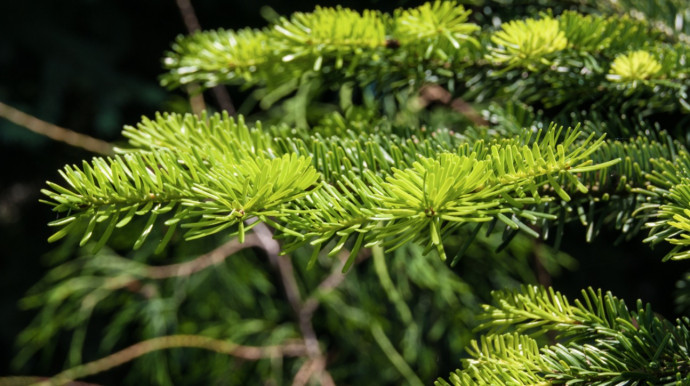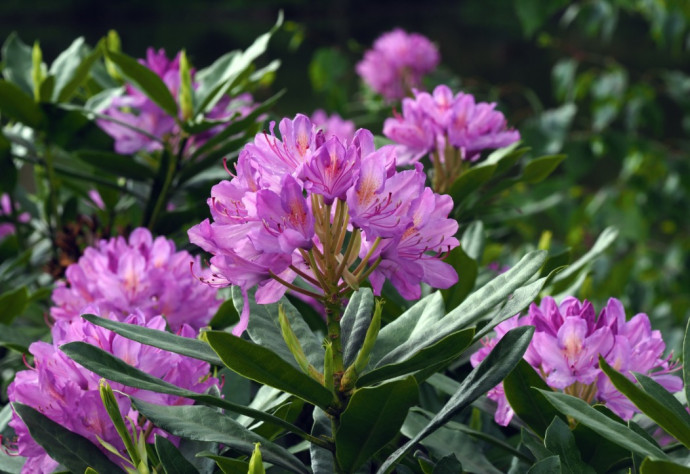1. Hydrangea

Hydrangeas are a favorite among gardeners because of their variety of flower colors and appearances. Some bloom in large, round clusters, while others have a smaller, flatter appearance. Hydrangea species tend to be quite comfortable in partial shade under tall deciduous trees (i.e., trees that lose their leaves in winter). Too little light will reduce their bloom, but too much sun and heat can cause the plant to wilt. Ideally, they should get morning sun, followed by some shade in the afternoon. Make sure they get a little more water on particularly hot days.
2. Astilbe

The secret to growing a flowering astilbe is water, and lots of it. These plants should never be allowed to dry out, so a location near a pond or stream is ideal. Astilbes are slow growing and produce plum-like flowers on stems above the foliage in spring and summer. They do best in partial shade, but can tolerate heavier shade. However, they are unlikely to reach their maximum size in full shade.
3. Rhododendron

Gardening under trees is not always easy because of the shade and competition with tree roots for soil moisture and nutrients. Where many other plants would die under the protection of trees, rhododendron species thrive. These flowering shrubs bloom in spring to early summer, and their root systems don't like being exposed to heat. Therefore, a shady location is ideal. Surrounding your shrub with mulch will keep the roots cool and maintain soil moisture.
4. Lungwort

A nice feature of lungwort plants is that they spread steadily, but not invasively, over the years and form a large colony. These plants bloom early in the spring when most other plants are just coming out of hibernation. The flowers are bell or funnel shaped and grow in clusters. Lungwort prefers to grow in partial to full shade, but will tolerate more sun if the weather is still cool. Too much light can burn the foliage, while too much shade can minimize flowering.
5. Fuchsia

These nice plants are prized for their bright, teardrop-shaped flowers on drooping stems. As shade-loving flowers, fuchsias thrive in areas that receive little light. They should definitely be protected from strong afternoon sun. Also, a spot sheltered from the wind is ideal. What fuchsias don't like is hot summer wind, which acts on them like a hairdryer. Keep the soil moist, but not wet, and feed your plants once a month with a basic fertilizer for annual flowers.
6. Siberian Bugloss

Siberian hornwort is a long-lived, low-maintenance plant that is one of the best flowers for shade. Its tiny, bright blue flowers with white centers bloom in spring and resemble the flowers of forget-me-nots. Siberian guensel prefers a shady spot and needs more frequent watering when growing in sunnier conditions. Too much light can burn the foliage and cause the plant to go dormant.
7. Flowering Dogwood (Cornus florida)

Flowering dogwoods are small understory trees in nature and make excellent large shrubs or small shade trees in a landscape. 'Cherokee Chief' (Cornus florida 'Cherokee Chief') is a popular variety of flowering dogwood tree. Its lower branches have a horizontal branching pattern that adds interest to any landscape design. This flowering dogwood grows to a height of 20 to 25 feet and spreads 12 to 15 feet.
The Cherokee Chief dogwood blooms pinkish-red in the spring, while its fall foliage is colored red with hints of bronze. Other species of Cornus florida have white or pink flowers.
Caution. Dogwoods are susceptible to a fungal disease known as dogwood anthracnose. Better consult your local experts to determine whether this disease is a problem in your area.
8. Canadian Hemlock (Tsuga canadensis)

Canadian (or "eastern") hemlocks (Tsuga canadensis) are large trees (40 to 70 feet) that do well in shade, provided you can give them the right conditions (well-drained soil, no drought or high winds). Hemlocks are best known as woodland trees, but if they are pruned conscientiously, they can be kept at the desired height. A properly pruned row of Hemlocks can even form a dense and attractive privacy hedge.
9. Yew (Taxus spp.)

The genus Taxus includes several dozen species of woody conifers and shrubs, ranging from prostrate shrubs to towering trees. Most species used in landscaping are shrubs, all of which do quite well in partial shade. The short, flat needles of yews are dark green on top and light green on the underside. The new foliage in spring is light green and soft. Yews are relatively slow growing and can either be left unpruned or grown into a hedge.
Hybrid varieties in the Taxus x media group are crosses between Japanese yews and English yews. Taunton yews (Taxus x media 'Tauntonii') are the best yews for regions with harsh winters because they are resistant to winter blight. These shrubs grow about 3 to 4 feet tall and have a similar spread.
Yews do not grow well in wet soil, so fill in dense soils to loosen them before planting.
10. Impatiens (Impatiens walleriana)

This popular flowering bedding plant, a mainstay of shady gardens, disappeared from garden centers for some time due to a widespread fungal problem known as downy mildew. Thanks to the development of varieties resistant to this disease, Impatiens have now reappeared. Impatiens may never regain the widespread popularity they once enjoyed, but they are once again worthy of attention because there are almost no other plants that bloom so vigorously under shady conditions. Impatiens grow 6 to 24 inches tall, depending on the variety. This shade-loving plant comes in various shades of pink, rose, red, purple, violet, orange and white. If planting from seed, make sure your varieties are known to be resistant to downy mildew.











